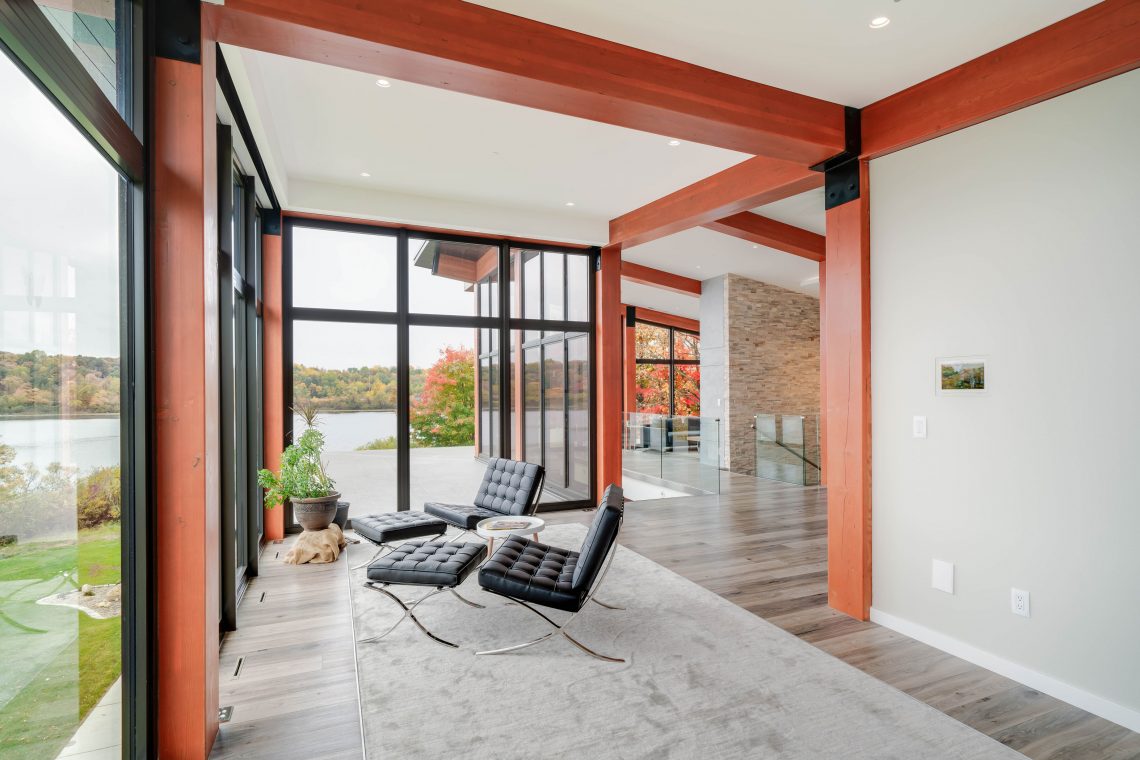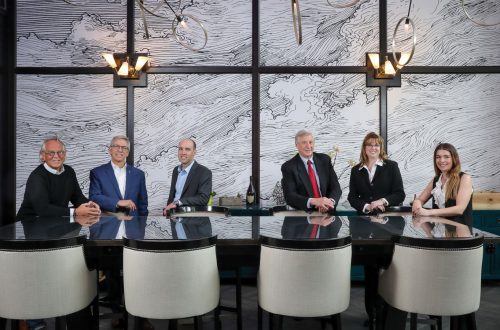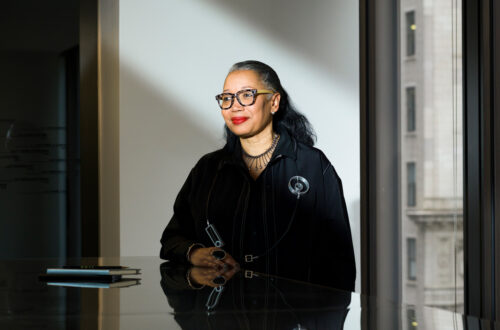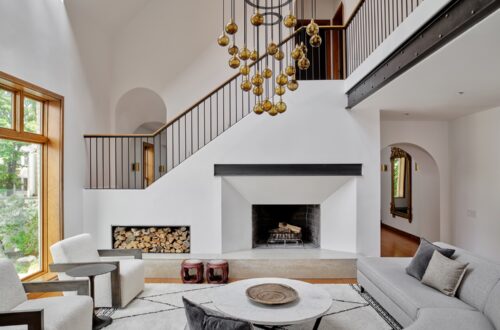From a collaborative, interactive design approach transforming architecture at the speed of ideas, to its status as a Tribally-Owned, 8(a) and HUBZone certified, and Small Disadvantaged Business, Seven Generations Architecture and Engineering LLC is a unique business in its small hometown of Kalamazoo and state of Michigan. The firm was founded in 2012 by Mno-Bmadsen, the independent, non-gaming investment arm of the Pokagon Band of Potawatomi, and has since more than tripled in size and expanded into a headquarters in Kalamazoo’s historic River’s Edge District, on the ancestral, traditional, and contemporary lands of the Anishinabek.
So far, the Seven Generations portfolio includes multi-million-dollar contracts in federal, state, municipal, commercial, and Tribal markets across the United States; the first of which included a 35,000-square-foot outpatient health clinic for the Indian Health Service—which equaled roughly $12 million—and then an approximately 80,000-square-foot health clinic for the Mille Lacs Band of Ojibwe in Minnesota that equaled roughly $18 million. As a firm that is also specially dedicated to architectural development for Tribal communities, Seven Generations’ portfolio retains a national clientele and importance that has grown exponentially throughout the last eight years, and its work is seen in Indiana, Minnesota, South Dakota, New Mexico, Texas, and Washington, D.C.
“When I started in this company five years ago, we were four people and we’re closer to 50 now, so with that comes a sort of commitment to not only win work, but also to start to better define what we’re trying to be as a company and as a whole and defining ourselves around some of the values that are the origin of the company,” said Steve VandenBussche, LEED AP, Vice President of Practice, and Senior Healthcare Architect at Seven Generations AE.
As a firm founded by Mno-Bmadsen—which was also established in 2012 to diversify the Pokagon Band’s business interests, revenue streams, and wealth for future generations—another key part of the firm’s mission is to honor and advance the Tribe’s goals, make stronger connections to the Indigenous communities it serves, and assist in their sustainability, cultural preservation and celebration, and sovereignty, VandenBussche added.
The firm has completed several projects for the Pokagon Band in southwest Michigan, as well as other Tribes nationally, such as the White Earth Nation in Minnesota, which commissioned preliminary designs for a cultural center and archive building that would honor and celebrate its history, and the Menominee Indian Tribe of Wisconsin, for which it created a proposal for the restoration of a historic waterfall and the creation of a surrounding nature park in Kenesha, Wisconsin.
Its services are specialized yet diverse, with concepting specialties comprising energy modelling and interactive, in-consultation 3D modelling, and research and consulting services that include model making and data collection. On the design and planning end, Seven Generations offers healthcare and urban design, master planning, facility assessment, and landscape architecture, as well as interior design, sustainable design, and architecture. Each project, no matter the client or service, is informed by Seven Generations’ and the Pokagon Band’s foundational values for sustainability.
“Seven Generations AE is aligned with the Pokagon Band’s emphasis on environmental sustainability and in particular, we’re guided by the concept of seven generation sustainability. This means the current generation should live sustainably and work for the benefit of the seventh generation, into the future,” VandenBussche said. “When we begin designing buildings thinking about efficiency or considering expansion, we do it while thinking about how our decisions today will impact the environment or inhabitants in the future.”
For Seven Generations, sustainable decision-making encompasses everything from studying site conditions in relation to the sun, water quality, and high-efficiency HVAC systems, to favoring materials with a lower embodied energy footprint such as timber as opposed to alternatives like steel. Another benefit to utilizing more natural materials is that they infuse new structures with biophilic elements that are often important for Tribal communities commissioning the firm, and especially in a pandemic-era that emphasizes outdoor usage, they provide a valued connection to a project’s surroundings.
One exemplary project is the Mille Lacs Band District 1 Health Clinic in Onamia, Minnesota. Created for the Mille Lacs Band of Ojibwe, north of Minneapolis, the health center rests on a large stretch of wetland and greenspace and features strong visual pathways to its surroundings to enhance the connection between Tribal members and the significance of the inland lakes.
At two stories and approximately 78,000 square-feet, the healthcare center provides a wide range of services including physical therapy, lab work, behavioral health, family services, dental work, imaging and radiology, and general health clinic services. As a comprehensive clinic serving users that sometimes travel long distances, the space is meant to accommodate multiple appointments in a day and long visits.
“The idea is that a lot of these Tribal members live quite a distance away; in a lot of communities going to the doctor is sometimes a family affair and they spend the day there,” VandenBussche said. “We wanted to make the space comfortable and welcoming so that if they were going to spend a few hours there they would have a comfortable place to hang out, and the kids could run around a little bit in a family-oriented environment.”
Natural materials like stone and wood provide connections to the natural environment and a large curtain wall reveals vast views of the wetlands from all waiting areas throughout the clinic. The design is also informed by other cultural indicators like accent colors on the exterior, interior signage in English and Ojibwe translation, and custom terrazzo tilework evoking the patterns of quilt or basket making. The overall structure was also designed with future opportunities for expansion in mind. To accommodate for added flooring, for example, sections of roofing and other structural elements were designed to require minimal reconfiguration in the structural steel body and even in the utility lines.
Regardless of project sector, whether in healthcare, Tribal markets—the places they overlap—commercial, or residential work, the skills and services held by Seven Generations, such as their interactive design capabilities and attention to the personal nature of each project in the research and collaborative process enable the firm to create entirely customized visions on behalf of each singular client and their unique needs. Especially in Tribal markets the firm serves, the need for absolute customization in design for each community requires rigorous attention to detail and infuses each project with a dual-folded mission: one for creating sustainable and functional designs that enhance quality of life, and another for supporting and celebrating culture.
“Every tribe is extremely unique; it’s almost like working with different families [on] the biggest custom home you’ve ever designed in a lot of cases,” VandenBussche said. “That has required us to be really rigorous about the research we do up front before we get too far into a project, because you might show up at a meeting and have a whole new Tribal leadership or community who haven’t seen the project so you have to make sure your story is accurate and it’s reflective of the Tribal community.”
It’s a challenge VandenBussche and the other members of Seven Generations are passionate about, and, according to the architect, a large reason some team members came on board in the first place. This important work continues in a near-future roster of projects with the National Park Service, which recently awarded Seven Generations a five-year contract for historic preservation throughout the U.S. The first project will be a rehabilitation and restoration at the Elkhorn West Overlook in Pea Ridge National Military Park, in Garfield, Arkansas.
As an active observer and supporter of culturally significant and respectful design, the firm will pay close attention to the site’s role in Cherokee history and move beyond the careful act of restoring the historic site into a role in re-storying its narrative. Telling entire stories of conceptual and natural space, including those elements that have traditionally been overlooked, is an important piece of Seven Generations’ ability as an architectural practice with the power to literally transform these spaces. Paired with its foundational goal for sustainably crafting spaces that support coming generations, the Kalamazoo-based firm’s multi-cultural, multi-industrial, and national body of work plays an integral role in respecting existing space and culture, and positioning it for the future.
Full text available in Great Lakes By Design: Architectonics, 2020
Text: R. Collins
Photography: Seven Generations Architecture and Engineering LLC






